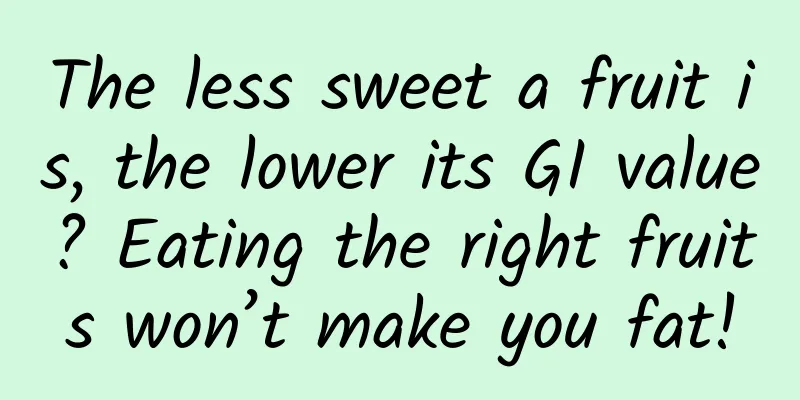The less sweet a fruit is, the lower its GI value? Eating the right fruits won’t make you fat!

|
Some people like to eat fruits, but they dare not touch "very sweet fruits" for fear that the high sweetness of fruits will make people fatter and gain weight. Nutritionists remind us not to think that the sweeter the fruit, the more you should avoid it, or that the less sweet a fruit is, the lower its GI value (low glycemic index). In fact, the secret of fruit GI value lies not in sweetness but in "fiber". "579 of fruits and vegetables, healthy every day" is the long-lasting slogan of the National Health Administration. However, how should 579 be combined to achieve the perfect health-preserving effect? You can’t just pick a few fruits and vegetables and eat them at random. You need to eat them in appropriate amounts and follow the low GI principle to truly enjoy the delicious taste and stay healthy and slim! The secret of fruit GI value is not sweetness People who have experience in weight loss are most worried about their blood sugar levels fluctuating, so they dare not eat foods with high glycemic index (high GI value). Therefore, some people think that fruits are more natural, especially since many fruits are not too sweet. It seems that fruits that are not sweet are low GI fruits and can be eaten with confidence. As a result, in addition to eating them after meals, I also often ate these non-sweet fruits between meals, which caused my blood sugar to soar. In addition to not overdoing your fruit intake, nutritionist Su Yanchen said that the secret of fruit's GI value lies not in its sweetness but in its "fiber." The benefit of fiber is that it can delay the absorption of sugar in the stomach and intestines, thereby preventing the rapid secretion of insulin in the body and converting the absorbed sugar into fat for storage. Papaya and pear are both juicy and delicious fruits, but they are low GI ingredients. Because both fruits are high in fiber, they can be eaten safely within the portion size. Papaya and pear are low GI and high in fiber. For example, papaya and pear are both juicy and delicious fruits, but they are low-GI ingredients. Since both fruits are high in fiber, they can be safely consumed within the prescribed amount. Watermelon, which quenches thirst and relieves heat, is about 93% water and contains low fiber, allowing the sugar that enters the body to be quickly absorbed without hindrance. Especially in the hot summer, people often juice watermelon, which makes the GI value "there is no highest, only higher", and will cause drastic fluctuations in blood sugar. In the long run, it is easier to gain weight. Drinking low GI fruits into juice may lead to more sugar intake Nutritionist Su Yanchen said that the key to the GI value of fruit, in addition to fiber, is texture. No matter how low the original GI value of the fruit is, it must be recalculated as long as it is made into juice. This is not wishful thinking or wishful thinking. The fundamental reasons are: 1. The quantity, and 2. The fruit residue. For example, an 8-ounce bowl of papaya weighs about 200 grams, which is just right for breakfast or afternoon tea. However, after being juiced and filtered, there may be less than 100cc left. If you want to satisfy your appetite, you may end up drinking more sugar without realizing it, which in turn causes your blood sugar to soar and your weight to get out of control. In addition, the filtered fruit residue is actually the essence of the fruit - "fiber". If you really want to make juice, in addition to choosing low-GI fruits, you must also remember how to calculate the portion. Use the original fruit as the basis, one portion at a time, and don't filter the residue after blending. This is the best way to maintain the advantages of low-GI fruits. Finally, I still have to remind you that although low GI fruits are good, you must limit the amount. Children should have 2 servings per day, adult women should have 3 servings, and adult men should have 4 servings. Take them separately, one serving at a time. Also, the essence of low GI fruits is fiber. Don't filter the juice by straining the residue, which will filter out the essence. |
<<: Insufficient fat intake may lead to increased body fat? ! Three principles for healthy oil use
>>: 3 tips to avoid obesity! Doctor: Stay away from abdominal obesity first
Recommend
Are cervical warts sexually transmitted?
Everyone knows that cervical warts are a sexually...
Understand the main hazards of cervical erosion
Cervical erosion is a local feature of chronic ce...
Dietary taboos for uterine fibroids? Patients with uterine fibroids cannot eat high-fat diets
Uterine fibroids are one of the common genital di...
What are the four major complications of abortion?
What are the complications of abortion? If aborti...
Reduce calories + increase metabolism = successful weight loss
He squatted until his legs were sore, and decided...
Learn from Eddie Peng: only 3% body fat and BMI should not be too low
For the movie "SPL", actor Eddie Peng b...
What is the normal level of prolactin during pregnancy?
The normal value of prolactin during pregnancy is...
What are the symptoms of irregular menstruation in women?
Irregular menstruation often occurs in young wome...
Is it normal to have no menstruation after 3 days? It may be normal
If a woman's menstruation stops three days af...
Are six-pack abs and mermaid lines a healthy body shape?
Recently, a reader asked Scott a good question: A...
What should I do if I have bacterial vaginosis?
The symptoms of patients with bacterial vaginosis...
What foods should not be eaten for cervical precancerous lesions
Cervical precancerous lesions are the most common...
Can men take Wuji Baifeng Pills? Treat prostate hyperplasia
Although Wuji Baifeng Pills is used to treat mens...
What exactly is candidal vaginitis?
What is candidal vaginitis ? What are the specifi...
What care should patients with Bartholinitis pay attention to?
Bartholinitis is a common disease in life. Knowin...









